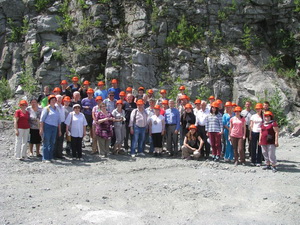
Organizers of the event included: NAS of Ukraine; the Institute of Geochemistry, Mineralogy and Ore Formation named after N.P. Semyonenko, the Public Service of Geology and Subsoil of Ukraine, State Gemological Center of Ukraine, Ukrainian Association of Geologists, Interagency Petrographic Committee, National Stratigraphic Committee. The conference was dedicated to granitoid, of the Ukrainian Shield, however, since colleagues from neighboring countries showed great interest in the issue, the forum became international.The forum considered the following issues: the genesis of acid rocks; the evolution of granitoid magmatism and ore formation; petrology of acid rocks; geochemistry of acid rocks; mineralogy of acid rocks; migmatites and granite formation; blackheads; pegmatites; isotope-geochronological dating of granitoid complexes; experimental studies of mineral-forming processes in acidic rocks.
Prior to the event, the oranizers published a summary of theses. A collection of polished samples of granitoids from objects of the future excursion was prepared as demonstration material.
The conference heard 46 oral reports and 81 poster presentations. During the excursion, geologists studied porphyritic granites of the Korosten complex, uniformly granular granites of the Zhytomyr complex, intrusive granodiorite of the Buki complex, garnet-biotite cordieritome granites of the Berdychev complex and viniticites in the outcrops and quarries. The route was designed in such a way that, crossing the southern part of the Volyn mega block and the northwestern part of the Dniester-Bug Megablock of the Ukrainian Shield, the sightseers could observe granites, ranging from relatively young Proterozoic to ancient Archean formations.